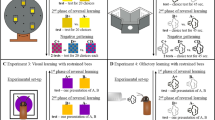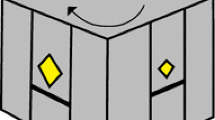Abstract
Five experiments on honeybees examined how the learning of a second task interferes with what was previously learned. Free flying bees were tested for landmark-based memory in variations on a paradigm of retroactive interference. Bees first learned Task 1, were tested on Task 1 (Test 1), then learned Task 2, and were tested again on Task 1 (Test 2). A 60-min delay (waiting in a box) before Test 2 caused no performance decrements. If the two tasks had conflicting response requirements, (e.g., target right of a green landmark in Task 1 and left of a blue landmark in Task 2), then a strong decrement on Test 2 was found (retroactive interference effect). When response competition was minimised during training or testing, however, the decrement on Test 2 was small or nonexistent. The results implicate response competition as a major contributor to the retroactive interference effect. The honeybee seems to hold on to memories; new memories do not wipe out old ones.



Similar content being viewed by others
References
Anderson MC, Spellman BA (1995) On the status of inhibitory mechanisms in cognition: Memory retrieval as a model case. Psychol Rev 102:68–100
Bitterman ME (1996) Comparative analysis of learning in honeybees. Anim Learn Behav 24:123–141
Bouton ME (1993) Context, time, and memory retrieval in the interference paradigms of Pavlovian conditioning. Psychol Bull 114:80–99
Bouton ME, Nelson JB, Rosas JM (1999) Stimulus generalization, context change, and forgetting. Psychol Bull 125:171–186
Cartwright BA, Collett TS (1982) How honey bees use landmarks to guide their return to a food source. Nature 295:560–564
Cartwright BA, Collett TS (1983) Landmark learning in bees. J Comp Physiol A 151:521–543
Cheng K (1998a) Distances and directions are computed separately by honeybees in landmark-based search. Anim Learn Behav 26:455–468
Cheng K (1998b) Honeybees (Apis mellifera) remember two near-target landmark constellations. Learn Motiv 29:435–443
Cheng K (1999a) Landmark-based spatial search in honeybees: I. Use of elements and interlandmark angles. Anim Cogn 2:73–78
Cheng K (1999b) Landmark-based spatial search in honeybees: II. Using gaps and blocks. Anim Cogn 2:79–90
Cheng K (2000) How honeybees find a place: Lessons from a simple mind. Anim Learn Behav 28:1–16
Cheng K (2005) Context cues eliminate confusions from response competition in honeybees (Apis mellifera). J Exp Biol 208:1019–1024
Cheng K, Collett TS, Pickhard A, Wehner R (1987) The use of visual landmarks by honeybees: Bees weight landmarks according to their distance from the goal. J Comp Physiol A 161:469–475
Cheng K, Collett TS, Wehner R (1986) Honeybees learn the colour of landmarks. J Comp Physiol A 159:69–73
Cheng K, Spetch ML (2001) Blocking in the spatial domain in honeybees. Anim Learn Behav 29:1–9
Chittka L (1998) Sensorimotor learning in bumblebees: Long-term retention and reversal training. J Exp Biol 201:515–524
Chittka L, Thomson JD (1997) Sensori-motor learning and its relevance for task specialization in bumble bees. Behav Ecol Sociobiol 41:385–398
Colborn M, Ahmad-Annuar A, Fauria K, Collett TS (1999) Contextual modulation of visuomotor associations in bumble-bees (Bombus terrestris). Proc R Soc Lond B 266:2413–2418
Collett TS, Collett M (2002) Memory use in insect visual navigation. Nature Rev Neurosci 3:542–552
Collett TS, Fauria K, Dale K (2003) Contextual cues and insect navigation. In: Jeffery KJ (ed), The neurobiology of spatial behaviour, Oxford University Press, Oxford, pp 67–82
Collett TS, Fauria K, Dale K, Baron J (1997) Places and patterns—a study of context learning in honeybees. J Comp Physiol A 181:343–353
Collett TS, Kelber A (1988) The retrieval of visuo-spatial memories by honeybees. J Comp Physiol A 163:145–150
Collett TS, Rees J (1997) View-based navigation in Hymenoptera: multiple strategies of landmark guidance in the approach to a feeder. J Comp Physiol A 181:47–58
Collett TS, Zeil J (1998) Places and landmarks: An arthropod perspective. In: Healy S (ed), Spatial representation in animals, Oxford University Press, Oxford, pp 18–53
Dukas R (1995) Transfer and interference in bumblebee learning. Anim Behav 49:1481–1490
Dukas R (1999) Costs of memory: ideas and predictions. J Theor Biol 197:41–50
Dyer FC, Gould J (1983) Honey bee navigation. Am Scientist 71:587–597
Fry SN, Wehner R (2002) Honey bees store landmarks in an egocentric frame of reference. J Comp Physiol A 187:1009–1016
Giurfa M, Zhang SW, Jenett A, Menzel R, Srinivasan MV (2001) The concepts of ‘sameness’ and ‘difference’ in an insect. Nature 410:930–933
Koltermann R (1969) Lern- und Vergessensprozesse bei der Honigbiene—aufgezeigt anhand von Duftdressuren [New data on processes of learning and forgetting, gained from scent training of honey-bees]. Z vergl Physiol 63:310–334
Koltermann R (1971) 24-Std-Periodik in der Langzeiterrinerung an Duft- und Farbsignale bei der Honigbiene [Circadian memory rhythm after scent and colour training with honey-bees]. Z vergl Physiol 75:49–68
Kraemer PJ, Golding JM (1997) Adaptive forgetting in animals. Psychonomic Bull Rev 4:480–491
Laughlin SB (2001) Energy as a constraint on the coding and processing of sensory information. Curr Opinion Neurobiol 11:475–480
MacLeod CM, Dodd MD, Sheard ED, Wilson DE, Bibi U (2003) In opposition to inhibition. In: Ross BH (ed) The psychology of learning and motivation, vol 43, Academic Press, San Diego, pp 163–214
Menzel R (1968) Das Gedächtnis der Honigbiene für Spektralfarben. I. Kurzzeitiges und langzeitiges Behalten [The honey bee's memory of spectral colours. I. Long-term and short-term retention]. Z vergl Physiol 60:82–102
Menzel R (1969) Das Gedächtnis der Honigbiene für Spektralfarben. II. Umlernen und Mehrfachlernen [The honey bee's memory of spectral colours. II. Reversal learning and learning of several colours]. Z vergl Physiol 63:290–309
Roberts WA (1998) Principles of animal cognition, McGraw-Hill, Boston
Smith BH, Cobey S (1994) The olfactory memory of the honeybee Apis mellifera. II. Blocking between odorants. J Exp Biol 195:91–108
Srinivasan MV, Zhang SW, Gadakar R (1998a) Context-dependent learning in honeybees. Proc 26th Göttingen Neurobiol Conference: 521. Thieme, Stuttgart
Srinivasan MV, Zhang SW, Zhu H (1998b) Honeybees link sights to smells. Nature 396:637–638
Von Frisch K, Lindauer M (1954) Himmel und Erde in Konkurrenz bei der Orientierung der Bienen [Sky and Earth in competition in the orientation of bees]. Naturwissenschaften 41:245–253
Wahl O (1932) Neue Untersuchungen über das Zeitgedächtnis der Bienen [New investigations on memory for time in bees]. Z vergl Physiol 18:709–717
Zentall TR (1997) Animal memory: the role of “instructions”. Learn Motiv 28:280–308
Acknowledgments
The work reported here was supported by a research grant from the Australian Research Council to KC (#9403/2133). The research was written up while K. Cheng was a Fellow at the Berlin Institute for Advanced Study, for whose support he is thankful. Thanks are also due to Dagong Zhang, Daniela Strano, Karen Bayly, and Greg Holwell for help with collecting data, to Mark Peterson for help with beehive maintenance, and to Tom Collett and Tom Zentall for helpful comments. Portions of the results reported here were presented at the annual meetings of the Animal Behavior Society, Boise, Idaho, July, 2003, and the Australasian Society for the Study of Animal Behaviour, Canberra, Australia, April, 2003.
Author information
Authors and Affiliations
Corresponding author
Rights and permissions
About this article
Cite this article
Cheng, K., Wignall, A.E. Honeybees (Apis mellifera) holding on to memories: response competition causes retroactive interference effects. Anim Cogn 9, 141–150 (2006). https://doi.org/10.1007/s10071-005-0012-5
Received:
Revised:
Accepted:
Published:
Issue Date:
DOI: https://doi.org/10.1007/s10071-005-0012-5




